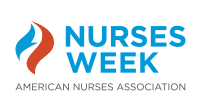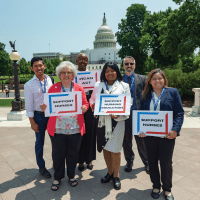More than 1,100 nurses and other professionals gathered at ANA’s 2017 Conference in Tampa, Florida, March 8-10, to learn about the latest research, strategies, and best practices for improving safety, quality, and staffing in their healthcare facilities. “Nursing work environment, staffing, nurse health, patient and nurse satisfaction—all affect outcomes,” said ANA President Pamela F. Cipriano, PhD, RN, NEA-BC, FAAN, in welcoming attendees to the conference themed “Translating Quality into Practice.”
Cipriano spoke of the strides nurses have made in ensuring quality care and emphasized the importance of engaging consumers in transforming health and health care—one of ANA’s strategic goals. “As we think about nurses serving consumers, what we focus on is quality,” Cipriano said. “Our work is not only [to ensure] that their experience is great but that they have a great outcome.” She added, “As health care changes around us, one thing remains certain: ANA is working relentlessly to amplify nurses’ voices as policies are being created, fought for, and implemented.”
Shifting decision-making to consumers
Consumer voices are being elevated in the changing landscape of health care, with a transition to value. Opening keynote speaker Harry Greenspun, MD, chief medical officer and managing director, Korn Ferry Health Solutions, identified three factors for nurses to address in transforming health care: coordinating care, using big data, and the importance of a consumer focus.
“The data we have is not necessarily the data we need,” Greenspun said. Patients need data that help them understand risk and expected outcomes, for better or worse, he explained. As members of interdisciplinary teams, nurses are positioned to rally around patients and support them as they evaluate personal decisions about care plans and determine if those plans are right for them, Greenspun said.
Shifting the culture
With a cultural shift in health care from a provider to a consumer focus, nurses can look to leading consumer organizations and influencers for ways to engage and guide patients in making the best healthcare decisions.
Presenter Ed Tori, DO, associate director, MedStar Institute for Innovation (MI2), and director, MedStar Center for Health Influence and Engagement, offered suggestions for using influence and persuasion to yield dramatic results in improving engagement. “You move people with emotion,” Tori said. Quoting poet Maya Angelou, he added, “People will never forget how you made them feel.” He offered seven rules for influence, the first and most important being: “Manage your state.” For example, Tori suggested nurses do what helps prepare them for patient engagement by managing their emotions and physical health with proper rest, nutrition, and exercise.
Healthcare reform
On March 9, nursing and healthcare leaders participated in a panel discussion to address the latest developments surrounding Congress’ efforts to reform the nation’s healthcare system. “Policy is almost always informed by politics,” said ANA Senior Associate Director of Government Affairs Tim Casey. He described ANA’s intensive advocacy work, which included a public statement, ANA’s letter to Congress, and ongoing, respectful conversations with Congressional staff.
“Don’t underestimate the power of your voice—the collective voices of nurses,” Casey told the attendees gathered for the town hall. From a health system perspective, the panel included Jeff Doucette, DNP, RN, FACHE, CENP, vice president, Magnet® and Pathway to Excellence®, American Nurses Credentialing Center, former vice president and chief nursing officer, Bon Secours Health System; and Lillee Gelinas, MSN, RN, FAAN, Editor-in-Chief, American Nurse Today, past chief nursing officer, CHRISTUS Health.
Gelinas commented on a state of “certain uncertainty” affecting workforce issues and causing systems to delay major purchases. Doucette expressed concerns that health care is moving away from a focus on wellness, prevention, and care coordination.
“As professional nurses, we’re called upon to give our opinion as those who are knowledgeable about health care,” Doucette said. “Influence becomes our role.”
Attendees contributed to the discussion, highlighting the wave of recent consumer activism and providing a historical perspective of healthcare reform.
In concluding the event, Cipriano underscored the importance of action. “ANA is in conversations giving [critical] input, and our state nurses associations are also involved,” she said. “The public trusts us, and our Code [of Ethics for Nurses] articulates the inherent responsibility of our role.” Cipriano urged attendees to take a few minutes to determine what they can do to advocate for healthcare reforms that guarantee patients have access to safe, quality health care.
Cross-continuum care
The final conference day sessions continued to equip nurses for leading transformational change in health care.
“We must prepare for cultural and operational change in nursing practice,” said Carol Boston- Fleischhauer, JD, MS, BSN, chief nursing officer, The Advisory Board Company, in the general session “Care Across the Continuum: New Nursing Roles.” Reporting on trends, she noted, “One in every three healthcare dollars is wasted, according to the Institute of Medicine. The current system is challenged by the cost of chronic disease and poor care coordination.”
She emphasized that nurses are being looked to for solutions. “This is our ‘Kodak moment’—our opportunity to adapt to the world we find ourselves in,” she said. Boston- Fleischhauer pointed to ANA’s healthcare reform principles as consistent with cross-continuum care. She identified imperatives for nurse leaders, who must understand the changes and essential skills for the workforce needed across the continuum of care, and urged nurses to embrace change and prepare for new roles, including those in acute care settings, nurse-run clinics, home-health care, and long-term care.
Embracing change
Closing keynote presenter and motivational speaker Jeff Vankooten introduced seven habits to manage change effectively. “Every one of us is resilient,” Vankooten said. “We just need to practice it.” He gave examples from the lives of Mother Teresa and Florence Nightingale who demonstrated resilience in the face of adversity. And he stressed that practicing the tactics of resilience allows individuals to keep moving forward in their lives and career.
The conference included preconference sessions on staffing, ethical practice, and big data; 42 concurrent sessions on best practices; more than 100 exhibitors offering innovative solutions and opportunities; and more than 170 poster presenters with nurses sharing their knowledge.
Save the date for next year’s ANA Annual Conference, March 21-23, 2018, at Gaylord Palms Resort & Convention Center, Orlando, Florida. To learn more.


















